Articles
- Page Path
- HOME > J Korean Acad Nurs > Volume 40(4); 2010 > Article
-
Original Article
- Factors Influencing Depression in Elderly People Living at Home
- Myeong Ja Moon
-
Journal of Korean Academy of Nursing 2010;40(4):542-550.
DOI: https://doi.org/10.4040/jkan.2010.40.4.542
Published online: August 31, 2010
Associate Professor, Department of Nursing, Mokpo Catholic University, Mokpo, Korea.
- Address reprint requests to: Moon, Myeong Ja. Department of Nursing, Mokpo Catholic University, 894-1 Seokhyeon-dong, Mokpo 530-742, Korea. Tel: 82-61-280-5126, Fax: 82-61-280-5109, mjmoon@mcu.ac.kr
• Received: January 10, 2010 • Accepted: August 16, 2010
Copyright © 2010 Korean Society of Nursing Science
Abstract
-
Purpose
- This study was done to identify the factors which influence depression for elderly people who live at home.
-
Methods
- The participants were 134 elderly people living at home in M city. Data were collected from April 2 to 30, 2009 and analyzed using SPSS/WIN 12.0 and AMOS 5.0 program. I assumed path coefficients by doing path analysis to understand synthetically causal relationship which influences on depression.
-
Results
- Social support, sleep pattern and self esteem had significant direct effects on life satisfaction and accounted for 50% of the total variance in life satisfaction. Physical symptoms, sleep pattern and life satisfaction also had significant direct effects on depression and accounted for 59% of the variance in depression. But social support, self assertiveness and self esteem were not significant for depression.
-
Conclusion
- These results provide guidance for designing useful strategies to reduce depression in elderly people living at home.
- 1. Alexopoulos GS. Depression in the elderly. The Lancet. 2005;365:1961–1970.Article
- 2. An JY, Tak YR. Depressive symptoms and related risk factors in old and oldest-old elderly people with arthritis. Journal of Korean Academy of Nursing. 2009;39:72–83.ArticlePubMed
- 3. Beutel ME, Glaesmer H, Wiltink J, Marian H, Brahler E. Title Life satisfaction, anxiety, depression and resilience across the life span of men. Aging Male. 2010;13:32–39.PubMed
- 4. Cho NO, Yang KR, Hong YS, Lee EO, Cheo MA. The relationship between family function and depression of elderly according to their assertiveness and pattern of interaction in expanded families. Seoul Journal of Nursing. 1998;12:185–201.
- 5. Cho SB. Structural equation model. 1996;Seoul, Youngji Publishers.
- 6. Choi SJ. A study on the development of life satisfaction scale for elderly. Ewha Womans University Korean Culture Nonchong. 1986;49:233–258.
- 7. Djernes JK. Prevalence and predictors of depression in populations of elderly. Acta Psychiatrica Scandinavica. 2006;113:372–387.PubMed
- 8. Hair JF. Multivariate date analysis. 1979;Oklahoma, Petroleum Publishing Company.
- 9. Hwang HK. The effect of exercise program on depression, self-esteem, and life satisfaction of the elderly. 2007;Masan, Kyungnam University. Unpublished master's thesis.
- 10. Jeon BJ. Self-esteem: A test of its measurability. Yonsei Nonchong. 1974;11:107–129.
- 11. Jung IK, Kwak DI, Joe SH, Lee HS. A study of standardization of Korean form of geriatric depression scale (KGDS). Journal of Korean Geriatric Psychiatry. 1997;1:61–72.
- 12. Kaneko Y, Motohashi Y, Sasaki H, Yamaji M. Prevalence of depressive symptoms and related risk factors for depressive symptoms among elderly persons living in rural japanese community: A cross-sectional study. Community Mental Health Journal. 2007;43:583–590.PubMed
- 13. Kim KB, Sok SH. Factors influencing depression of the elderly. Journal of Korean Academy of Community Health Nursing. 2009;20:197–206.
- 14. Kim PK. A study on the relation between assertiveness and depression in the elderly. 1998;Seoul, Hanyang University. Unpublished master's thesis.
- 15. Korea National Statistical Office. Cause of death statistics. 2005;Seoul, Author.
- 16. Korea National Statistical Office. Statistics of aged. 2008;Seoul, Author.
- 17. Kroenke K, Spitzer RL, William JB. The PHQ-15: Validity of a new measure for evaluating the severity of somatic symtoms. Psychosomatic Medicine. 2002;64:258–266.ArticlePubMed
- 18. Lee HS. Health status and utilization of long-term care facility in the urban and rural aged. Journal of Korean Academy of Community Health Nursing. 2008;19:260–269.
- 19. Moon MJ. Analysis on the structural model of life satisfaction for elderly home residents. Journal of Korean Gerontological Nursing. 2004;6:202–215.
- 20. Oh JJ, Song MS, Kim SM. Development and validation of korea sleep scale A. Journal of Korean Academy of Nursing. 1998;28:563–572.ArticlePDF
- 21. Park JW. A study to develop a scale of social support. 1985;Seoul, Yonsei University. Unpublished doctoral dissertation.
- 22. Rakos RF, Schroeder HE. Development and empirical evaluation of a self-administered assertiveness training program. Journal of Consulting and Clinical Psychology. 1979;47:991–993.Article
- 23. Rosenberg M. Society and the adolescent self image. 1965;Princeton, NJ, Princeton University Press.
- 24. Segal DL. Relationships of assertiveness, depression, and social support among older nursing home residents. Behavior Modification. 2005;29:689–695.ArticlePubMedPDF
- 25. Seo HS, Han YH. Effects of health-related index on life satisfaction for the elderly people. Korean Journal of Research in Gerontology. 2006;15:159–170.
- 26. Shin KR, Kang YH, Jung DY, Choi KA. A study on the depression, somatic symptom, activities of daily living for the elderly women in an urban area. Journal of Korean Academy of Nursing. 2007;37:1131–1138.ArticlePubMedPDF
- 27. Song MS. Construction of a functional status prediction model for the elderly. 1991;Seoul, Seoul National University. Unpublished doctoral dissertation.
- 28. Taft LB. Self-esteem in later life: A nursing perspective. Advanced Nursing Science. 1985;8:77–84.
- 29. Tak YR, Kim SA, Lee BS. Perceived social support, instrumental support needs, and depression of elderly women. Korean Journal of Women Health Nursing. 2003;9:449–456.ArticlePDF
- 30. Yao KW, Yu S, Cheng SP, Chen IJ. Relationships between personal, depression and social network factors and sleep quality in community-dwelling older adults. Journal of Nursing Research. 2008;16:131–138.Article
REFERENCES
Figure & Data
REFERENCES
Citations
Citations to this article as recorded by 

- Institutional Satisfaction and Anxiety Mediate the Relationship Between Social Support and Depression in Hypertension Patients in Elderly Caring Social Organizations: A Cross-Sectional Study
Kai Ji, Zhongliang Bai, Ling Tang, Huosheng Yan, Ying Zhu, Guimei Chen, Ren Chen
Frontiers in Psychology.2021;[Epub] CrossRef - Social Support, Activities of Daily Living, and Depression among Older Japanese and Koreans Immigrants in the U.S
Bumjung Kim, Hyeyoun Jun, Jisun Lee, Yun Min Kim
Social Work in Public Health.2020; 35(4): 163. CrossRef - The Effect of Physical Health Variables on the Depression of the Korean Rural Elderly : with a Focus on a Comparison of Young-old and Old-old
Junggook Go, Jeonghwa Lee, Young eun Oh
The Korean Journal of Community Living Science.2019; 30(1): 83. CrossRef - Depression and Cognitive Function of the Community-dwelling Elderly
Seong Ok Seo, Ae Young So
Journal of Korean Academy of Community Health Nursing.2016; 27(1): 1. CrossRef - The Effects of Home Visit Healthcare Using a Complex Program on Community-dwelling Frail Elders' Strength, Frailty, and Depression
Hee Gerl Kim
Journal of Korean Academy of Community Health Nursing.2015; 26(4): 405. CrossRef - Developing a Community Capacity Builded Exercise Maintenance Program for Frail Elderly Women
Yeon Hee Choi, Sun Yi Hong
The Korean Journal of Rehabilitation Nursing.2015; 18(2): 153. CrossRef - Effects of Laughter Therapy on Depression in elderly
Mi Young Chang
Journal of Digital Convergence.2014; 12(6): 501. CrossRef - Prevalence and Its Influencing Factors on Depression among Elderly Vulnerable People in Urban Community
Hye-Ryoung Kim
The Korean Journal of Health Service Management.2013; 7(3): 275. CrossRef - Analysis of the Characteristics of the Older Adults with Depression Using Data Mining Decision Tree Analysis
Myonghwa Park, Sora Choi, A Mi Shin, Chul Hoi Koo
Journal of Korean Academy of Nursing.2013; 43(1): 1. CrossRef - A Predictive Model of Depression in Rural Elders-Decision Tree Analysis
Seong Eun Kim, Sun Ah Kim
Journal of Korean Academy of Nursing.2013; 43(3): 442. CrossRef - Factors Influencing Depressive Symptoms in Community Dwelling Older People
Jung Nam Sohn
Journal of Korean Academy of Psychiatric and Mental Health Nursing.2013; 22(2): 107. CrossRef - Prevalence of Depression and its Risk Factors among Aged at Social Service Centers in One Urban Community
Hye-Ryoung Kim
The Korean Journal of Rehabilitation Nursing.2013; 16(2): 79. CrossRef - Prediction of Depression among Elderly with Mild Cognitive Impairment Living in the Community
Kyung-Rim Shin, Youn-Hee Kang, Mi-Young Kim, Duk-Yoo Jung, Eliza Lee
Korean Journal of Adult Nursing.2012; 24(2): 171. CrossRef - Effects of a Recreational Combination Gymnastics Program for Old-old Women
Yeon Hee Choi, Choon Ji Lee
Journal of Korean Academy of Nursing.2012; 42(6): 843. CrossRef - Gender Difference in Risk Factors for Depression in Community-dwelling Elders
Chul-Gyu Kim, Seungmi Park
Journal of Korean Academy of Nursing.2012; 42(1): 136. CrossRef - Stigma, Self-esteem and Quality of Life of People with Hansen's Disease
Yang-Sook Yoo, Bock-Ryn Kim, Ok-Hee Cho
Journal of muscle and joint health.2012; 19(3): 272. CrossRef - Factors Influencing Depression Among Patients with Chronic Degenerative Arthritis after Total Knee Arthroplasty
Yeong-Ju Ju, Hee-Kyung Kim
Journal of muscle and joint health.2012; 19(2): 161. CrossRef - Impact of Body Mass Index and Perceived Health Status on Depression in Elderly Women Living Alone in the Community
Eun Kyeung Song, Youn-Jung Son
Journal of Korean Academy of Psychiatric and Mental Health Nursing.2011; 20(4): 376. CrossRef
Factors Influencing Depression in Elderly People Living at Home
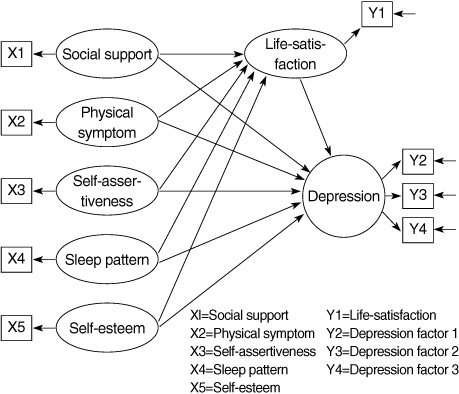
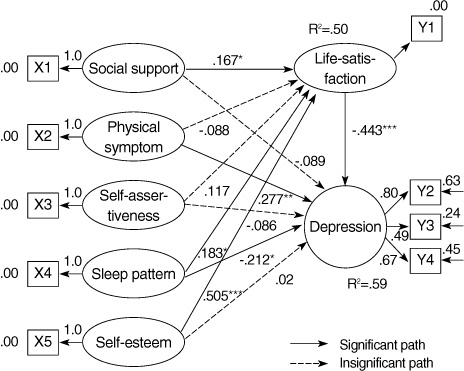
Figure 1
The hypothetical model.
Figure 2
Path diagram for hypothetical model.
Figure 1
Figure 2
Factors Influencing Depression in Elderly People Living at Home
General Characteristics of Participants (N=134)
Descriptive statistics of variables (N=134)
Correlational Matrix of the Study Variables
*p<.05; **p<.01; ***p<.001.
Standardized Parameter Estimates in the Model
*p<.05; **p<.01; ***p<.001.
t-value=estimate (or direct effect)/standard error; SMC=squared multiple correlations.
Table 1
General Characteristics of Participants (N=134)
Table 2
Descriptive statistics of variables (N=134)
Table 3
Correlational Matrix of the Study Variables
*
Table 4
Standardized Parameter Estimates in the Model
* t-value=estimate (or direct effect)/standard error; SMC=squared multiple correlations.
 KSNS
KSNS
 E-SUBMISSION
E-SUBMISSION


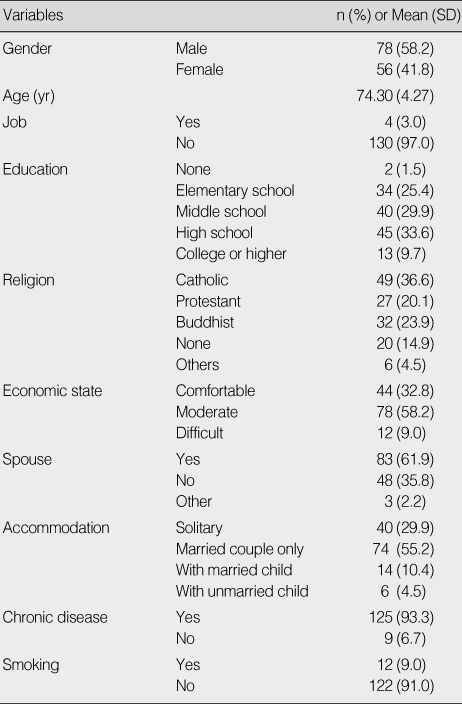
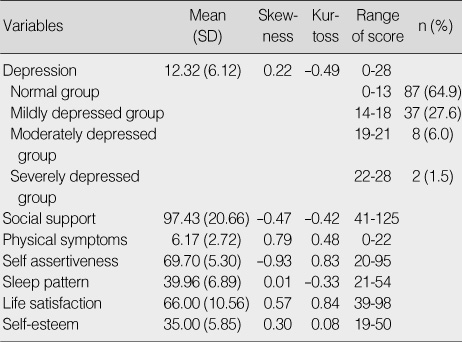
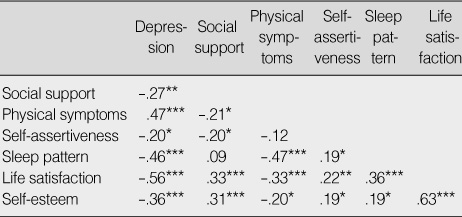

 Cite
Cite

